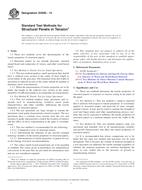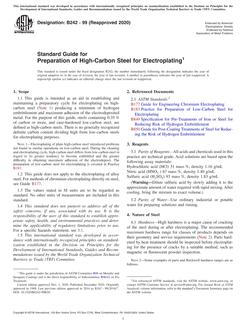1.1 This practice outlines a procedure to obtain a record of normalized resistance of sands to the penetration of a standard sampler driven by a standard energy for estimating soil liquefaction potential during earthquakes. The normalized penetration resistance determined in this practice may be useful for determination of other engineering properties of sands.
1.2 This practice uses Test Method D 1586 with additions and modifications to minimize disturbance of saturated loose cohesionless sands during drilling. This practice combines results of Test Method D 1586 and interprets the data for normalization purposes.
1.3 Due to inherent variability of the SPT, guidance is given on test configuration and energy adjustments. Penetration resistance is adjusted for energy delivered in the penetration test. Energy adjustments can be estimated or measured and reported.
1.4 Standard practice for normalizing penetration resistance values is given. Penetration resistance data are normalized to a standard overburden stress level.
1.5 The normalized penetration resistance data may be used to estimate liquefaction resistance of saturated sands from earthquake shaking. Evaluation of liquefaction resistance may be applied to natural ground conditions or foundations for either planned or existing structures.
1.6 Using this practice representative disturbed samples of the soil can be collected for identification purposes.
1.7 This practice is limited to use in cohesionless soils (see Test Method D 2487 and classifications of SM, SW, SP, SP-SM, and SW-SM Practice D 2488). In most cases, testing is performed in saturated deposits below the water table. In some cases, dry sands may be tested (see ). This practice is not applicable to lithified materials or fine grained soils. Gravel can interfere with the test and result in elevated penetration resistance values. Normalization of penetration resistance values for gravelly soils is beyond the scope of this practice.
Penetration resistance measurements often will involve safety planning, administration, and documentation. This practice does not purport to address all aspects of exploration and site safety.This standard does not purport to address all of the safety concerns, if any, associated with its use. It is the responsibility of the user of this standard to establish appropriate safety and health practices and determine the applicability of regulatory limitations prior to use. Performance of the test usually involves use of a drill rig; therefore, safety requirements as outlined in applicable safety standards. For example, OSHA regulations, DCDMA safety manual, drilling safety manuals, and other applicable state and local regulations must be observed.
1.8 The values stated in inch-pound units are to be regarded as standard. Within the text, the SI units, are shown in parentheses. The values stated in each system are not equivalents, therefore, each system must be used independently of the other.
1.8.1 In pressure correction calculations, common units are ton/ft², kg/cm², atm, and bars. Since these units are approximately equal (within a factor of 1.1), many engineers prefer the use of these units in stress correction calculations. For those using kPa or kN/m², 100 kPa is approximately equal to one ton/ft². The stress exponent, n, (see ) is approximately equal for these units.
1.9 This practice may not be applicable in some countries, states, or localities, where rules or standards may differ for applying penetration resistance to liquefaction estimates. Other practices exist for estimating soil instability from penetration resistance data. Procedures may change with advances in geotechnical engineering. It is dependent on the user in consultation with experienced engineers to select appropriate methods and correction to data. In earthquake engineering studies, many phenomena can affect soil instability. The practice reflects only one current exploration technique and method for normalizing penetration resistance data to a common level for comparisons to case history information.
1.10 This practice offers a set of instructions for performing one or more specific operations. This document cannot replace education or experience and should be used in conjunction with professional judgment. Not all aspects of this practice may be applicable in all circumstances. This ASTM standard is not intended to represent or replace the standard of care by which the adequacy of a given professional service must be judged, nor should this document be applied without consideration of a project’s many unique aspects. The word “Standard” in the title of this document means only that the document has been approved through the ASTM consensus process.
Product Details
- Published:
- 11/01/2004
- Number of Pages:
- 16
- File Size:
- 1 file , 230 KB


